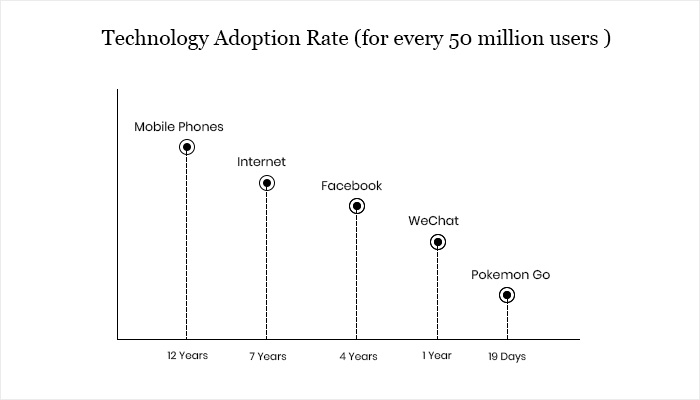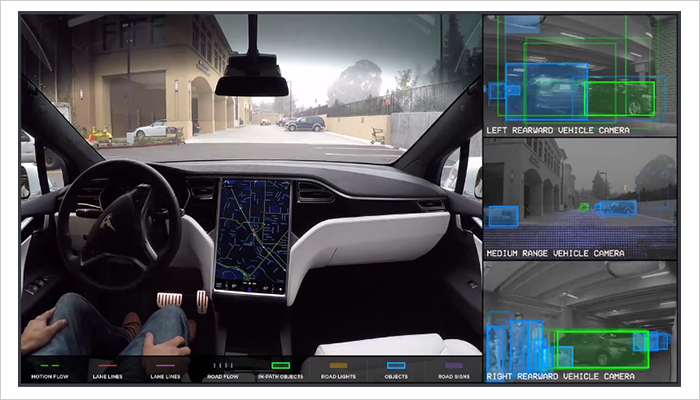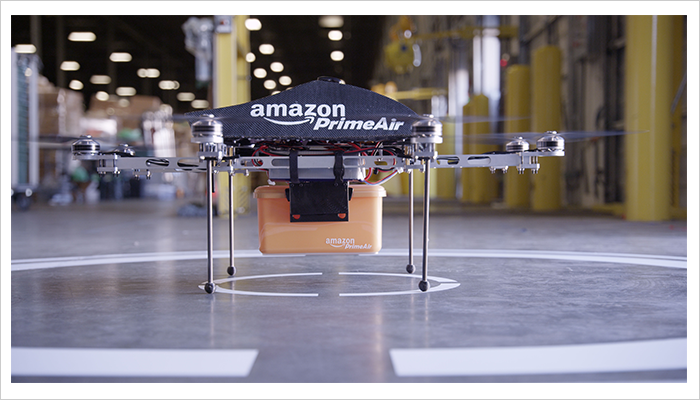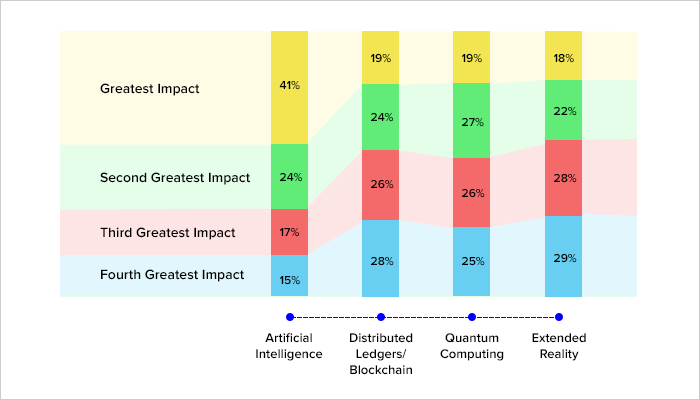

New Technology Trends for 2020
If you are still wondering ‘what’s new technology?’take a look at the newest tech trends that are hand-picked by our experts after doing extensive research:
1. 5G Network
One of the most enigmatic new upcoming technology that businesses will need to adopt is the advent of 5G. According to Huawei, 5G could
“support 1,000-fold gains in capacity, connections for at least 100 billion devices and a 10 Gb/s individual user experience of extremely low latency and response times.”
But to take this speed to everyday mobile users, mobile network carriers will need to increase bandwidth and reduce network costs. Moreover, LTE adoption isn’t waning and is estimated to reach $672 billion by the end of 2020.
2. Autonomous Driving
We all have heard about companies like Tesla, Alphabet, and Waymo, and the one thing that is common among them is their aim, which is to craft impeccable autonomous vehicles. The idea of a driverless car in itself generates a considerable amount of excitement.
Tesla chief Elon Musk already has the future design of autonomous vehicles and aims to go big in this industry.
Elon states,
“From our standpoint, if you fast forward a year, maybe a year and three months, but next year for sure, we’ll have over a million Robo-taxis on the road.”
Functions like automated braking, lane-changing, and automation of the other in-car systems are on its way to being streamlined with the guidance of data capture and analytics.

However, Gartner analyst Mike Ramsey thinks differently, which is true to an extent,
“The idea that you can have a vehicle that can make complex decisions for full self-driving is just not plausible at this point.”
There is still time for the modulation of the laws for autonomous driving by legislators, regulators, and authorities. Over that, significant tweaks will be required in the existing infrastructure, laws and social attitudes before we can embrace autonomous vehicles in the current technology trends.
3. The Empowered Edge
Today, the primary concern of any industry is the laggy approach that sometimes affects the overall management of the operations. Therefore, industries are focusing more on the efficiency and the response rate of computing, through which, data analysis is made. And here comes the role of edge computing.
Edge computing brings data storage and computation closer to the target, and hence, ameliorates the response times and save bandwidth. Also, it weighs more like the latest trend in technology because the industries are rapidly empowered with sophisticated and specialized compute resources, which is bound to reduce the latency.
As of now, edge computing is being fueled by the rapid evolution of the Internet of Things (IoT) and in the future, it will create an unstructured architecture over a set of distributed cloud services.
For instance, we have got drones that directly communicate with the enterprise IoT platform and conduct peer-to-peer exchanges. There is every increasing rise in the use of storage, sensor, computer, and advanced AI capabilities. One such example is the latest package delivery drone by Amazon.

4. Democratization of Technology
The term democratization is derived from democracy. Like in a democracy, everyone has equal rights and responsibility, the democratization of technology refers to the easy access of technical domain to everyone, irrespective of their profession and place.
Gartner asserts four key aspects of the democratization of technology trend that will make it big in 2020:
- Application development
- Design
- Knowledge
- Data and analytics
The best example of democratization can be credited to the developer, who will be able to generate data models without learning the skills of a data scientist.
However, there is still concern about the future use of this latest trend in information technology because it will also enable people to exploit easy-to-use tools, which may pose harm to society.
5. Human Augmentation
Human augmentation can be defined as a process by which a person’s physical and cognitive ability is strengthened. Once implanted in a human being, it will enable the person to execute tasks that were earlier impossible for him.
For instance, miners use wearables to enhance their safety. Then the cases of human augmentation in soldiers are a highly anticipated topic and are running silently by the armed forces of many countries, as per reports.
The augmentation humans will not only enhance the physical endurance of a person but also, it will enhance the human’s ability to think and decide better. To put it simply, we can say that human augmentation does hold substantial potential in the future of technology.
6. Distributed Cloud
The trends of cloud storage and cloud computing are already embraced by the industries across the globe and the next big thing that is going to hit the tech ecosystem is the distributed cloud system.
Distributed Cloud is still in its infancy and there is a long way to go. Many companies are up with their service subsets to be used in a distributed way. It helps in connecting the public cloud distributed operation of cloud services to specific locations.
It’s expected that by 2020, 75% of the enterprise-generated data will be processed regardless of the centralized data center. This upcoming technology of 2020 will be a significant breakthrough in the cloud infrastructure.
7. DARQ Age is Here
Distributed ledger technology (such as blockchain), Artificial intelligence (AI), Extended reality (including virtual and augmented reality), and Quantum computing, abbreviated to DARQ form one such future technology trend of 2020 that business must integrate on priority. So, when you approach hiring, training, and employee retention, keep DARQ in mind.
Volkswagen, for instance, is already cashing in one of the biggest technology trends of 2020. It used quantum computing to test traffic flow optimization and accelerate battery development.

The company is also testing distributed ledgers to provide automatic payments at gas stations, create tamper-proof odometers, protect cars from hackers and more. Similarly, it’s using AR instructions to help service employees repair vehicles.
8. Personal Profiling
Digital integration into people’s lives has become so deep that data analytics has more information than they could ever analyze with current technology. As consumer analytics becomes a crude priority of every business, the latest tech trend is profiling consumers by examining how they interact with the technology in hand.
To analyze the gateways to profiling user spending patterns, we need to answer questions like:
- What social media apps do they most visit?
- How do they curate their social profiles?
- What pictures do they post?
- What all places they check into on social media?
The trick here for businesses is to integrate and adapt to an individual’s preference for the latest technology. Gillette is one such example that’s partnering with 3D printing startup Formlabs to offer customized razor designs.
A top technology trend like this raises one glaring question – where is consumer consent in this personal profiling and where do we draw the socially acceptable line and how will this line differ from consumer to consumer?
Well, for that, we have to wait and watch the manner in which personal profiling is done in the future.
9. AI Products
Artificial technology or AI is not a new term in the IT sphere, but now there are further verticals of AI that is shaping the industries globally.
AI technology trends, including products like AlterEgo, a mind-reading wearable, and citizen robots like Sophia, are only a promo to how big AI technology will get in 2020. Companies like Dominos and Doordash are already experimenting with drones and robot delivery.


Recent Comments